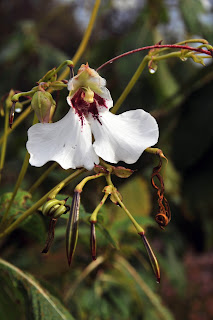By Nicola Temple
Some of my fondest memories of autumn are as a child holding my parent’s hands on a crisp afternoon, watching as my little red welly boots swished through the dried fallen leaves of the season. Even now as an adult, I can’t resist shuffling a little when conditions are right, just so I can watch the warm colours roll across my feet and listen to the rustle of autumn. However, last Friday Nick Wray, Curator for the Botanic Garden, opened my eyes to a whole new set of autumn delights – from winged bushes to exploding seed pods – this season is about so much more than just falling leaves.
 |
| The small orange fruits of G. tinctoria |
The first stop on our tour was the plant Gunnera tinctoria, which to the untrained eye looks very much like rhubarb on steroids, and as a result is commonly called giant rhubarb. This species is smaller than the one commonly seen in British gardens, Gunnera manicata, but otherwise looks the same. As the plant prepares for its dormant winter phase, the large leaves have started to bend to the ground, revealing a world of colour beneath. Wrapped in a sheath of red feathery tufts are the promises of next year’s growth – buds, which will grow over the winter months ready for next spring. Beside these are the large influorescences, rising up like staffs from the base of the plant. Here, thousands of tiny orange fruits are housed, each one the product of a tiny pollinated flower.
Growing on the north side of the house, in constant shade, is proof that autumn is still a time for flowers – Begonia grandis. This is a woodland plant from southern China and its pretty pink flowers are only one part of this plant’s colourful display. Turn the leaves over and an extraordinary cinnamon red is revealed.
 |
| Flower of B. grandis with the colourful dark underside of the plant’s leaves in the background. |
“This is an evasion strategy,” Nick starts to tell me, “plants can’t get up and run away from predators, but they can masquerade as something else. Herbivores mooching about through the understory are likely to think there’s something wrong with this plant as the leaves make it look as though it’s dead or dying.”
 |
| Flower of Impatiens tinctoria. |
This plant has been producing flowers since July and they are clearly built for bee pollinators. A deep crimson runway guides the bee toward its nectar reward and as it enters the flower, its back rubs along the anther, dusting it in pollen. The pollinated flowers produce a rather extraordinary seed capsule, which is of course another important aspect of autumn….dispersing the next generation.
 |
| The bladder-like fruits of Colutea arborescens |
Another wonderful example of autumn seed dispersal in the garden is the Bladder Senna, (Colutea arborescens). Though this plant doesn’t bring any colour to the garden at this time of year, the fruits offer their own element of intrigue. Native to the Middle East – Turkey, Iran, Iraq – the beige fruit resembles slightly deflated balloons dangling from the branches. Open it up, however, and inside you find two rows of perfectly paired little black seeds. As winter approaches, these fruits will fall off the tree and be carried across the dry land by the wind, much like tumbleweed. As the fruit tumbles along, it starts to tear and break down and the seeds get released. This type of seed distribution is very successful, particularly in the seasonally dry climates where it is found.
r pigments carotene and anthocyanin, giving the leaves their autumn colours.
 |
| The bright orange seed of E. alatus seems dull compared to the vibrant colour of the leaves |
Nick brings me over to Euonymus alatus, the colour of which almost hurts the eyes. The leaves are a fiery fuschia colour. This species is from China and it gets its name alatus, which means winged, from the hard sharp protrusions from the stem that protect the plant from herbivores. In the summer it’s a pleasant green shrub, but this time of year it is ablaze with colour. If the leaves weren’t enough, scattered throughout the bush are tiny fruits, which have split to reveal a single bright orange seed – a delicacy for birds.
 |
| H. mollis glowing gold against the evergreen backdrop of Atriplex humilis (Fat Hen family) |
Nick had to run to a meeting, but I stayed in the garden for another half hour, taking photographs and crouching down to look at plants from new angles and examine parts that are usually hidden by lush foliage any other time of year. It was a whole new way to experience autumn. Of course, I still shuffled through the fallen leaves on my way out…some things are sacred.

